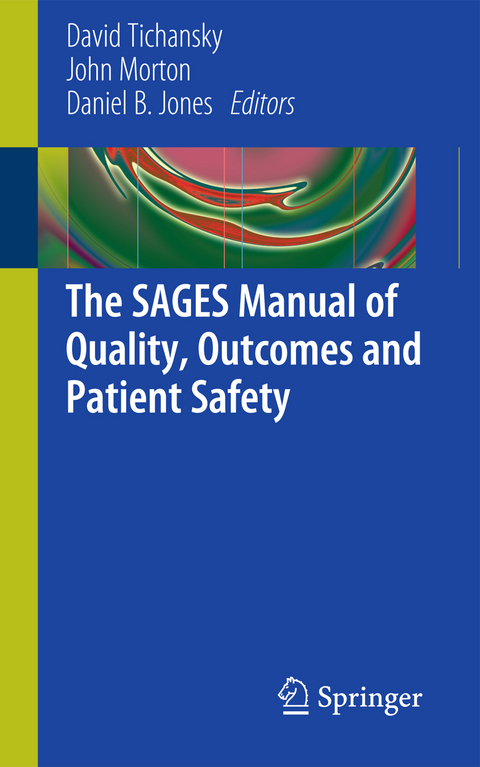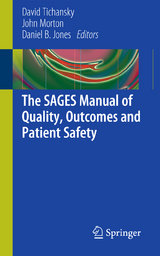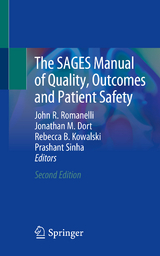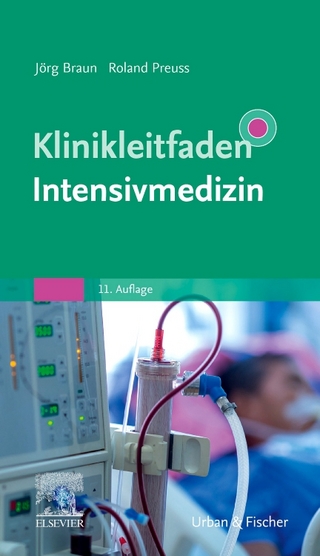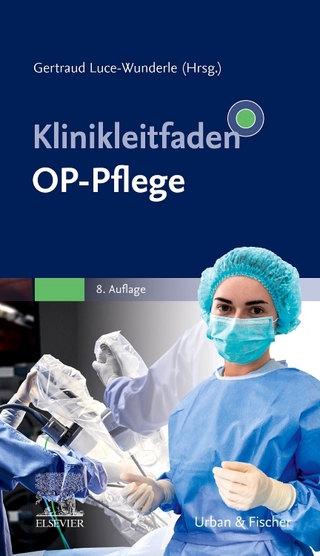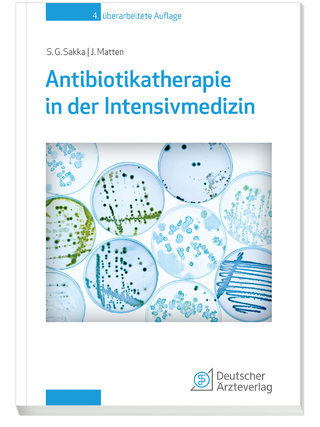The SAGES Manual of Quality, Outcomes and Patient Safety
Springer-Verlag New York Inc.
978-1-4419-7900-1 (ISBN)
- Titel erscheint in neuer Auflage
- Artikel merken
Dr. Jones has been an active member of SAGES since 1993, and he currently chairs the FUSE Task Force and Quality, Outcomes and Safety Committee. He has served as Chair of the the Educational Resources Committee, Vice Chair of the Legislative Committee, and member of the Continuing Education, FLS, Bariatric, Development and Program Committees. He was Poster Co-Chair 2002 and he coordinated the SAGES Appropriateness Conference on Treatment of Morbid Obesity 2003, Learning Center 2004 and 2005, Advanced Techniques Postgraduate Course 2006, Operating a Simulation Center Panel 2008, Best Practices for Surgical Treatment of Obesity Panel 2009. He has been project director of the SAGES Top 14 Videos, Inguinal Hernia Pearls, Web Quizzes, Bariatric Surgery Grand Rounds, Online Video Kiosk, and revised Patient Brochure educational materials. Dr. Jones was the recipient of the SAGES Young Investigators Award in 2001 and appointed to the Board of Governors in 2002. He has recently been appointed Program Chair for 2012 Annual Meeting. Dr. Tichansky is a currently the Director of Minimally Invasive and Bariatric Surgery at Thomas Jefferson University, the birthplace of SAGES. After earning a Bachelor of Science degree in mechanical engineering at Lafayette College in Easton, PA, he went on to attend UMDNJ-New Jersey Medical School in Newark where he obtained his M.D. in 1996 as a member of AOA. He completed his surgical residency at Thomas Jefferson University Hospital in Philadelphia and his Minimally Invasive and Bariatric Surgery Fellowship at the Medical College of Virginia in Richmond. After one year of private practice in Princeton, N.J., he accepted a faculty position with The University of Tennessee Health Science Center in Memphis, TN to pursue an academic career in Minimally Invasive Surgery in August 2004. While there he served as Associate Professor of Surgery, Chief of Minimally Invasive Surgery, Co-Director of the Weight Management Center at Methodist University Hospital, Co-Medical Director of Bariatric Surgery at the Regional Medical Center, Director of the Minimally Invasive Surgery Fellowship at UT, and a member of the Board of Directors for UT Medical Group. Dr. Tichansky returned to Jefferson in 2008 as an Associate Professor of Surgery and Director of Minimally Invasive and Bariatric Surgery. He has performed extensive research in the fields of Minimally Invasive and Bariatric Surgery to improve patient safety and care and has authored/co-authored more than 80 peer-reviewed articles, six book chapters, and greater than 100 scientific presentations. Dr. Tichansky is currently chairman of the Membership Committee of the ASMBS and serves on the Curriculum and Education Committee of the Fellowship Council. He is on the Editorial Board of the Journal of Gastrointestinal Surgery and also serves on the Publications, Membership, and Quality, Outcomes and Safety committees of SAGES. Dr. John Morton is Associate Professor of Surgery at Stanford University serving as Section Chief of Minimally Invasive Surgery and Director of both Bariatric Surgery and Surgical Quality. He also heads the Minimally Invasive Surgery fellowship and the Stanford Center for Outcomes Research and Evaluation (SCORE) and is Co-Director of the Stanford Digestive Health Center. Dr. Morton received undergraduate, Masters in Public Health, and Medical Doctor Degrees from Tulane University and a Masters in Health Administration from University of Washington. He was the first surgical resident to receive a Robert Wood Johnson Clinical Scholar Fellowship in the program’s history at University of Washington and also completed an advanced laparoscopic fellowship at University of North Carolina, Chapel Hill. He served on Capitol Hill as Senator Bill Frist’s Health Policy Intern. He has published over 60 peer-reviewed articles and 10 book chapters with over 100 national and international oral presentations.
PART I: PATIENT SAFETY IS QUALITY.- Defining Quality in Surgery.- Never Events.- Creating a Surgical Dashboard for Quality.- Patient-Centered Outcomes: Patient Satisfaction and Quality of Life Assessment.- Quality, Safety and Electronic Medical Records.- Leading Change: System Improvement.- Surgical Timeout and Retained Foreign Bodies-- Patient Safety in the Operating Room.- SAGES Laparoscopic Surgery Safety Checklist.- Faculty Hour: A Model for Interdisciplinary Quality Improvement.- Creating Effective Communication and Teamwork for Patient Safety.- Clinical Care Pathways.- Data Drives Quality – ACS – NSQIP.- Clinical Research Improves Patient Care.- National Patient Safety Guidelines.- PART II - UNDERSTANDING ERROR.- Taxonomy of Errors: Adverse Event/Near Miss Analysis.- Disclosure of Complications and Error.- Second Opinion and Transfer of Care.- Morbidity and Mortality Conference.- PART III - PREOPERATIVE RISK ASSESSMENT.- Preoperative Risk Assessment – Anesthesia.- Preoperative Cardiac Considerations in General Surgical Patients.- Pulmonary Effects of Obesity and Assessment for Bariatric Surgery.- Contraindications to Laparoscopy.- PART IV - COMMON COMPLICATIONS & MANAGEMENT.- Common Complications and Management.- Common Endoscopic Complications: Recognition and Management.- Energy and Energy Safety in the Operating Room.- Laparoscopic Cholecystectomy: Complications and Management.- Antireflux Surgery for GERD.- Complications of Bariatric Surgery.- Complication in Colorectal Surgery.- Solid Organ Surgery.- Outline for Sages, handbook of safety, and improved clinical outcomes.- Video -Assisted Thoracic Surgery: Complications and Management.- Robotic Surgical Outcomes and Safety.- Complications in Single-Incision Laparoscopic Surgery.- NOTES: Common Complications and Management.- PART V - ORGANIZATIONS PROMOTING SAFETY & QUALITY.- Quality and Safety in American College of Surgeons.- Institute of Medicine Crossing the Quality Chasm.- Using Patient Safety Indicators as Benchmarks.- Institute for Healthcare Improvement-Best Practices.- SAGES History & Commitment To Education and Safety.- PART VI - PROFESSIONAL EDUCATION.- Standardizing Surgical Education: Implications for Quality of Care.- Training Standards/Fellowship Council.- Accreditation Standards: Bariatric Surgery and Beyond.- PART VII - SAFER SURGERY THROUGH SIMULATION AND TEAMWORK.- Team Training.- Training to Proficiency.- FLS.- FES.- Simulation and OR Team Performance.- Debriefing after Simulation.- Using Simulation for Disclosure of Bad News.- Teleproctoring in Surgery.- PART VIII - MEDICAL-LEGAL CONSIDERATIONS.- Informed Consent.- Enterprise Risk Management.- Surgical Devices: Equipment malfunction, FDA reporting, Off-label use.- Video recording: Responsibility and Liability.- Limiting Medical Malpractice Exposure and Claims.- The Expert Witness and Tort Reform.- PART VIIIII – CONCLUSIONS.- Conclusion: Culture of Safety and Era of Better Practices.
| Zusatzinfo | 28 Illustrations, color; 9 Illustrations, black and white; XXVIII, 597 p. 37 illus., 28 illus. in color. |
|---|---|
| Verlagsort | New York, NY |
| Sprache | englisch |
| Gewicht | 689 g |
| Themenwelt | Medizin / Pharmazie ► Allgemeines / Lexika |
| Medizin / Pharmazie ► Medizinische Fachgebiete ► Chirurgie | |
| ISBN-10 | 1-4419-7900-X / 144197900X |
| ISBN-13 | 978-1-4419-7900-1 / 9781441979001 |
| Zustand | Neuware |
| Haben Sie eine Frage zum Produkt? |
aus dem Bereich
